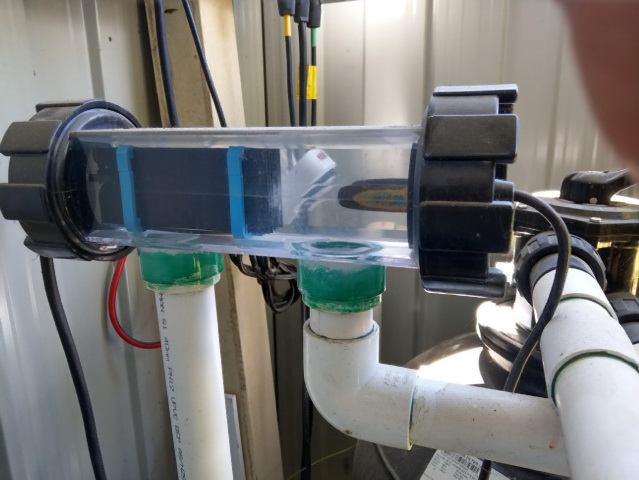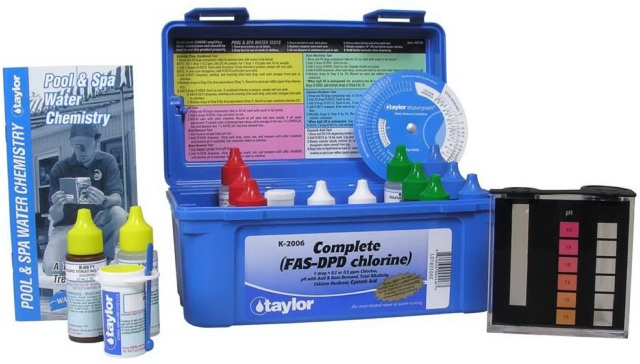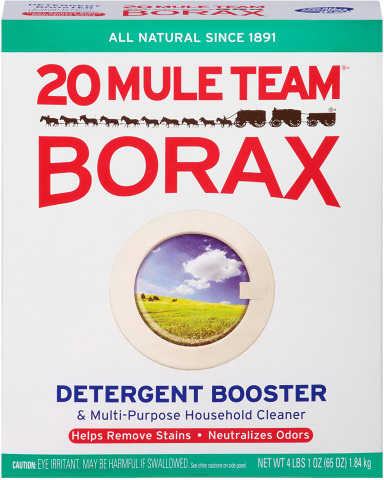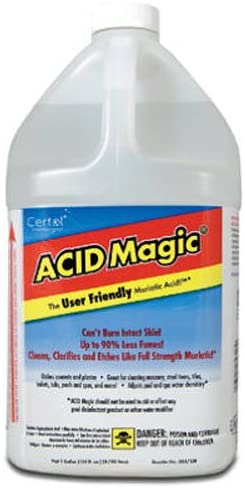Having a salt water chlorinator cell constantly clog up can spell a lot of trouble. The water clarity in your pool will suffer. But what is the cause of this?
The chief cause for your salt water chlorinator clogging up can be due to calcium buildup. This can cause your pool to cloud up and even cause damage to your salt cell should there be enough buildup. The last thing you ever want is a salt cell that is unable to function due to the amount of buildup it has accrued over the course of time.
Let’s go into detail on what is causing your salt water chlorinator cell to clog up all the time.

Article Contents
What is the White Buildup On Salt Cell?
The white buildup on a salt cell is none other than calcium. This calcium scaling can occur due to the following: pH levels and the temperature of the water. The higher either are, the more calcium buildup is likely. If the pH levels are not maintained, you will see more of this build up occur.
If left unattended, the calcium buildup can leave stains that can be hard to get rid of. The more vigilante you are in getting rid of calcium buildup in your pool, the better.
You can remove it with a salt cell cleaning product like this one:

Why is Salt Water Cell Constantly Clogging
The salt water cell can get clogged constantly for several different reasons. While it may sound difficult at first, it’s important to know the multiple factors that play a role in clogging your salt water cell. Let’s take an in-depth look at the following factors and what you need to do to prevent them from causing buildup:
Water Type Impacts pH levels
Needless to say, the type of water you have in your pool will affect the pH levels. In the next point, we will talk about the pH level you need to keep the water at in order to prevent calcium build up in your salt cell. The pH levels, whether they are below or above the recommended amount, should be monitored regularly.
pH levels
Salt water chlorinators (aka chlorine generator) tend to elevate the pH levels of your pool’s water. You’ll want to keep the pH levels between 7.2 to 7.4. If the pH levels reach 7.8 or higher, then that means the water is alkaline. The higher the pH, the more likely calcium buildup will occur.
You’ll need to regularly test the pH of your pool, 1-2 times per week. Make sure your test methods are accurate too. Sometimes, these pH tests will tell a different story when there are obvious signs of high pH and calcium build up. You may find out about the pH levels when it’s too late and there’s enough calcium to affect your pool’s water along with the pipes as well.
Use a good quality test kit like this one:

Your pH levels could even drop, leading to potential issues with the salt cell (including false alarms). Try to keep the pH levels between the recommended amount.
Chlorine levels
Chlorine is designed to keep the pool water clean. You’ll want to keep it between 3 to 5 ppm. A high amount of chlorine can cause issues such as eye and skin irritation. Not to mention, high chlorine levels can also lead to more calcium hardness.
Keeping chlorine levels to their normal amounts can reduce the calcium hardness and keep buildup on a salt cell to a minimum. Be sure to test the chlorine levels to ensure that they are within that range.
It’s important that you don’t run the salt water chlorinator for a lengthy period of time too. The longer it runs, the more likely it will build up with that flaky white calcium. In order to keep it to a minimum, usually 8-12 hours a day is plenty, setting the chlorinator at around 50% output.
Calcium hardness
Calcium hardness needs to stay within 180 to 300 ppm. At this level, the salt cell will be difficult to clog. The calcium hardness levels will depend on your water’s overall chemistry. If the calcium hardness levels are high enough, scale build up will rapidly increase.
Keep an eye out for other minerals that can build up as well. This includes but is not limited to sulfates, phosphates, and silicates. These will cause the water clarity to become drastically reduced.
Total Alkalinity (TA) Levels
Your total alkalinity (or TA levels) are something you want to pay attention to. If you have a high level of carbonates in your water, it will be very hard to reduce the pH levels in your water. That’s why you need to keep them anywhere from 100 to 90 ppm.
Related Reading: How to Fix a Leaking Chlorinator
Is Calcium on Salt Cell Bad?
A little calcium on the salt cell electrodes is OK, however heavy flaky deposits that clog up the electrodes will impede the salt cell from working properly. Your salt cell should be able to turn the small amount of salt found in your pool to chlorine and if it is blocked up with white flakes of calcium, it will not do this.
You salt cell controller will usually have a display screen to provide you with information while it is working. It can also alert you of any potential problems, if detected. For example, you may have warning lights that will indicate whether or not it may need cleaning. You can also receive warnings about higher levels of voltage or irregularities with the amperage.
How to Prevent Salt Cell Clogging Up with Calcium
The best ways to prevent your chlorine generator clogging up is to keep your pool water balanced. We’ve listed above why your salt cell clogs up.
The two most important things to minimise calcium buildup or calcium deposits on the salt cell are to:
- Keep the pool pH levels between 7.4 and 7.6
- Keep the pool pH levels between 7.4 and 7.6
No it’s not a typo. You should know that this is one of the most important steps in preventing your saltwater generator from getting clogged up.
As I mentioned, saltwater pools push up the pH because of the way the system works. So you’ll need to control this by adding muriatic acid to bring down the pH.
And to help stabilize the pH, you can add borates to your pool at around 50 ppm. What are borates? Also known as borax and you can get it in near the laundry powder.
By adding borax, this will help buffer the pH level and prevent calcium building up.

Maintaining calcium hardness and total alkalinity is also a must to prevent calcium.
Related Reading: When & How Often To Clean Pool Salt Cell? (Answered!)
How Often Should You Clean A Salt Cell? What’s Normal?
Cleaning your salt cell should be something you need to do on the regular basis. It’s not uncommon for salt cells to need cleaning every two to six months (or as needed). It is important that you keep it clean so the salt cell can function properly. Failure to do so can cause the salt cell to not work as intended.
If you’re having to clean your salt cell more regularly than every two months, there’s a good chance your pH is not balanced or you have hard water (a lot of calcium in the water). One fix for hard water is to ship in bought water.
Many saltwater generator control units have a light that indicates when it’s necessary to clean the cell.
Keep in mind that the calcium will be drawn in by the electrical plates that are responsible for electrolysis and chlorine production. If there is too much calcium buildup or clogging on the cell electrodes, this process cannot occur. If you have a salt system that is self-cleaning, this may not be something to worry about.
How to Remove Calcium Buildup from Your Salt Cell
This is something we cover in-depth here:
How to Clean a Pool Saltwater Cell Like a Pro!
But for a quick overview, here is a basic rundown.
You can remove it with a salt cell cleaning product like this one:

Or you use muriatic acid. The basic methodology is to remove calcium from a salt cell is to use a solution mixed with the following: one gallon of water and one cup of muriatic acid. Remove the cell from the pool system and place it in the solution and let it soak for approximately 10 minutes. After that, be sure to flush out anything that is left behind with a hose to ensure that all deposits have been removed.
You can use muriatic acid to clean a salt cell:

Also, you need to be aware that there is a wrong way to clean your salt cell. Here’s what you should not do:
- Do not soak your salt cell in the solution for a lengthy period of time. 20 minutes or more is too much time
- Keep the acid strength to a minimum. Abide by the 15:1 rule
- If the salt cell is not coated visibly, do no clean it at all
- Never use metal tools to scrape off any leftover deposits. This can damage your salt cell
Final Thoughts
Your salt water chlorinator cell can clog up constantly if you don’t properly monitor it and maintain the correct chemical balance in your pool’s water. Failure to clean calcium from it on a regular basis can lead to issues as well.
That’s why it is important to check your salt cell often. Clean it every two to six months or every 500 hours it is used. You’ll likely have an indicator that will help you determine when it may be time to clean it. False alarms can occur, so you want to check on the water’s temperature, chlorine levels, and other factors before making the determination that your salt cell is to blame.
If you have a pool that has a salt cell, now is the time to check on it. You may also need to clean it as soon as possible so it can function properly.


Hi, We have a 25,000 L pool.
It has a swc.
We seem to be putting a lot of muriatic acid in pool to maintain the ph at about 7.4: 2 cupfuls a week. Soon there will be more acid than water, I fear.
We seem to be cleaning the swc about every 2-3 weeks, not every two months.
Is there a better system? Is there an automatic feed ( of hcl and chlorine with sensor) system that would do the job better? To better monitor the ph?
Or a reverse osmosis system maybe?
Rising pH is a byproduct of having a saltwater swimming pool. The first thing you can do to combat rising pH is to run your saltwater generator less. You will likely only need it on 9-12 hours during the summer and less in winter. Next, you can minimize the increase in pH by setting your pump to run for an extra 20 mins after the SWG shuts off. And finally, you may be able to reduce your chlorine levels to 2 ppm by running the saltwater chlorine generator for less time or at less power. pH rise because you’re running the SWG. If you don’t want to manually add acid, you can get automatic acid feeders. They cost several hundred dollars. There are also CO2 dosing machines available. They may be hard to find.